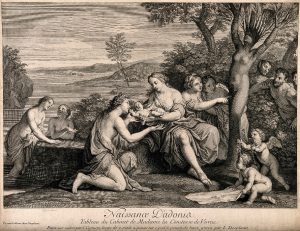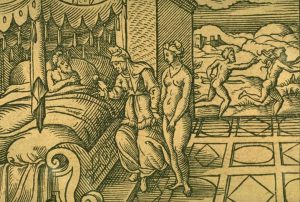
May 15, 2018, by Helen Lovatt
Incest and Incense: A study session at the Nottingham Contemporary
Thea Lawrence on ancient perfume and the myth of Myrrha at Nottingham Contemporary Art Gallery
In conjunction with their most recent exhibition, The House of Fame, the Nottingham Contemporary is running a series of (free!) study sessions, grouped under the alluring title of A Darkened Room: On Feminism, Rituals, Death and the Occult. For the first of these, I ran a session entitled ‘Incense, perfume, incest and (im)pietas’. The session was built around a reading of Ovid’s version of the myth of Myrrha, from book 10 of his Metamorphoses. Narrated by Orpheus as an example of ‘crimes provoked by women’s lust’, this is the longest extant version of this myth, and invites a whole host of readings (as Ovid always does).
The tale of Myrrha is about as salacious as myth gets – the eponymous Myrrha develops a distinctly un-daughterly passion for her own father, King Cinyras, and, under the cover of night and with the (questionably overenthusiastic) assistance of her devoted nurse, manages to trick said father into bed. After several busy nights of blissful (or wilful) ignorance, Cinyras finally discovers the identity of his lover, which forces Myrrha to flee for her life from his sword-brandishing anger. Weary and heavily pregnant with her own half-brother, Myrrha begs some unspecified gods for an end to her suffering. Some deity hears her prayer, and transforms her into the myrrh tree, thus suspending her forever between life and death, ensuring that her incestuous crime will not pollute either realm. Sometime later, Myrrha-the-tree gives birth to Adonis, who is immediately anointed with the fragrant tears of his mother, myrrh.

Myrrha (half woman half tree) giving birth to Adonis, engraving by L. Desplaces after C. Cignani (16th- 17th century)
Although Ovid’s characterisation of Myrrha is complex and sometimes sympathetic, she is in many ways the embodiment of Greco-Roman stereotypes about the weaknesses and excesses of women. She is unable to control her excessive and unnatural desires, and resorts to trickery to fulfil them. Cinyras, meanwhile, is exempted from any blame, despite an eagerness to hop into bed with a stranger as young as his daughter (at the very moment his wife is observing ritual celibacy) which to modern eyes is at least somewhat seedy. The myrrh which she weeps after her transformation is an important constituent of many ancient perfumes, which were themselves deemed to be both (immorally) erotic and deceptive, concealing the natural stench of the body it adorns even as it works its seductive influence upon others.
The central text served as an excellent springboard into broader conversations about ancient (and modern) attitudes towards the taboo of incest, the role of metamorphoses in myth, and myrrh as a highly-prized perfume and incense. One of the great joys of the session was the diversity of approach and perspective brought by those in attendance. One attendee, who sells a variety of products containing myrrh, felt that discovering that it had such an ancient and disturbing myth behind it had caused her to look at it in a new light. She was still wrestling with the problem of how to view a substance with such a long and complex cultural history. This was a response to the myth stayed with me – in my own research into myrrh in Greco-Roman antiquity, a central question is the degree to and ways in which Myrrha’s story might factor into the attitudes of those using the real substance. It had never occurred to me that it might also have an impact upon those working with myrrh today. In fact, the whole session was a poignant reminder of the ways in which discussion of sources like Ovid’s tale of Myrrha, and of the ancient practices and social attitudes to which they are connected, is only enriched by the presence of a wide range of perspectives – including and perhaps even especially from those who do not inhabit my specific academic bubble.
No comments yet, fill out a comment to be the first


Leave a Reply